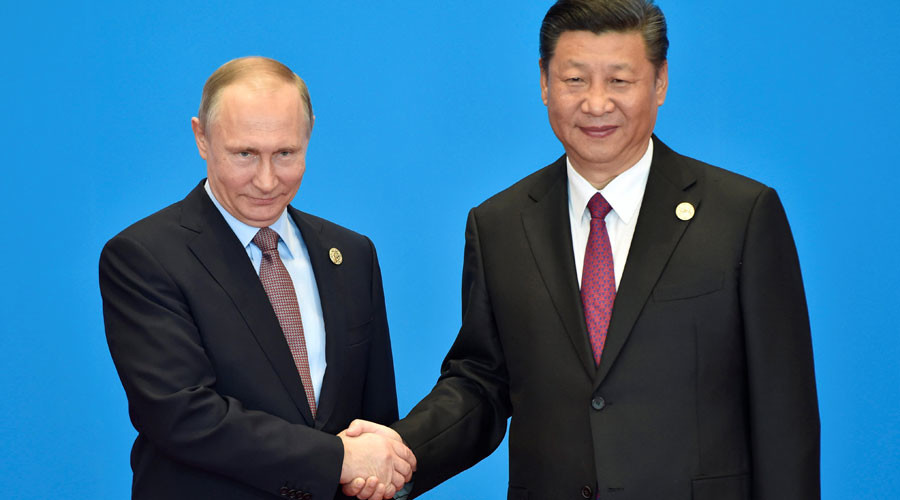Putin Aligns with Xi in Crafting the New World (Trade) Order
BRICS, 22 May 2017
15 May 2017 – History will record the Belt and Road Forum in Beijing marked the juncture where the 21st century New Silk Roads assumed their full character of Globalization 2.0, or “inclusive globalization,” as defined by President Xi Jinping in Davos earlier this year.
I have dealt with the monumental stakes here and here. Terminology, of course, remains a minor problem. What was once defined as One Belt, One Road (OBOR) is now promoted as the Belt and Road Initiative (BRI). Much is still somewhat lost in translation in English, what matters is that Xi has managed to imprint the myriad possibilities inbuilt in the concept especially across the Global South.
An amiable host, Xi in Beijing went ‘no holds barred’ extolling the inclusive integration merits of OBOR/BRI. It also helps that along the way, this being China, his spin doctors came up with a lovely metaphor to illustrate how OBOR/BRI should find its force as a common, pan-Eurasian effort; “Wild Swan geese [found across Asia but not in Europe] are able to fly far and safely through winds and storms because they move in flocks and help each other as a team.”
And arguably the key member of this flock of wild swan geese happens to be Russia.
https://twitter.com/RT_com/status/864150647289073664?ref_src=twsrc%5Etfw&ref_url=https%3A%2F%2Fwww.rt.com%2Fop-edge%2F388458-putin-xi-china-forum%2F
Follow the geese
President Putin and Foreign Minister Sergey Lavrov were guests of honor at the forum – alongside leaders such as Kazakhstan’s Nazarbayev and Turkey’s Erdogan. At a business breakfast discussion, Xi seated Putin to his right and Lavrov to his left.
At a Leaders Roundtable summit on the second day of the forum – a sort of Silk Road United Nations, with the microphones open equally to all – Putin touched on a key point; the symbiosis, formalized since 2015, between OBOR/BRI and the Russia-driven Eurasian Economic Union (EEU), currently formed by Russia, Kyrgyzstan, Kazakhstan, Belarus, and Armenia.
As Putin said, “some 50 European, Asian and Latin American states” are interested in cooperation with the EEU. While the EEU and China are discussing their own, wide-ranging trade/economic deal, the EEU is also consulting, among others, with Iran, India, Serbia, Singapore, and Egypt.
But it was during his speech at the inaugural session of the forum that Putin managed to distill what amounts to a concentrate of Russian foreign policy.
httpv://www.youtube.com/watch?v=9yXc_T7g5wI
Here are the key topics.
- Through “integration formats like the EEU, OBOR, the SCO, and ASEAN, we can build the foundation for a larger Eurasian partnership.”
- There is now a “unique opportunity to create a common cooperation framework from the Atlantic to the Pacific – for the first time in history.” Essentially, this is what Putin himself had once proposed – then shunned by EU/NATO – even before Xi announced OBOR in 2013.
- “Russia is not only willing to be a reliable trading partner but also seeks to invest in the creation of joint ventures and new production capacities in partnering states, to invest in industrial facilities, sales, and services.”
- Russia is investing in building “a system of modern and well-connected transport corridors,” “expanding the capacity of the Baikal-Amur Mainline and the Trans-Siberian Railway, investing significant resources into improvements to the Northeast Passage.”
- And then, looking at the Big Picture, “the infrastructure projects within the EEU and the One Belt, One Road initiative in conjunction with the Northeast Passage can completely reconfigure transportation on the Eurasian continent.”
- Putin expects “newly established financial institutions like the New Development Bank (BRICS Development Bank) and the Asian Infrastructure Investment Bank to offer a supporting hand to private investors.”
And then, the clincher, fully aligned with Xi’s vision; “Greater Eurasia is not an abstract geopolitical arrangement but, without exaggeration, a truly civilization-wide project looking toward the future.”
When in doubt, call the SCO
Compared with the depth and breadth of this shared vision, nothing could be more pedestrian than the official India attitude; not only sending a low-level delegation to Beijing, but imprinting on mainstream Indian media the notion that OBOR/BRI is “little more than a colonial enterprise [that would leave] debt and broken communities in its wake”.
The flock of wild swan geese flying toward Eurasia integration is now a fact of life. East Asian output, for that matter, will surpass North America’s during the Trump era. The future, rather, the dissolution of unipolar hegemony will be decided in Eurasia, particularly East Asia.
India may certainly harbor its own strategic agenda. But self-marginalization of the one and only integrated development project in the 21st century hardly qualifies as savvy diplomacy.
So it looks like Putin once again will have his work cut out for him. India, a historical partner of the former USSR, still maintains good trade relations with Russia. Iran, for its part, is as much a key Indian energy partner as China’s. So the road map ahead spells out Moscow, alongside Tehran, playing the go-betweens trying to sweeten India into the Eurasia integration path.
That could well take place within the framework of the Shanghai Cooperation Organization (SCO), which from now on will have a full plate not only trying to smooth out a feasible Afghan peace process but making sure India and Pakistan find a political entente cordiale.
It will be a bit like older brothers trying to instill some sense into younger ones – as Russia and China, as part of their strategic partnership, have already worked hard to manage the twin admission of India and Pakistan into the SCO.
Iran will also become a full member shortly. So we will soon have an active SCO from Southwest Asia all the way to South Asia, with a political-economic integration agenda expanding the initial drive to fight myriad manifestations of Salafi-jihadi terror.
This slowly but surely progressive convergence fits into the larger goals of the Russia-China strategic partnership, which once again, as demonstrated during the Beijing forum, is all about Eurasia integration.
The invisible story at the Beijing forum was that as much as Turkey is a key node of OBOR/BRI and Kazakhstan is a key node between OBOR/BRI and the EEU, it’s China and Russia that will truly advance the complex roadmap of this “civilization-wide project.”
__________________________________
 Pepe Escobar is a Brazilian independent geopolitical analyst. He is a frequent contributor to websites and radio and TV shows ranging from the US to East Asia. He is the former roving correspondent for Asia Times Online. He has been a foreign correspondent since 1985, and has lived in London, Paris, Milan, Los Angeles, Washington, Bangkok and Hong Kong. Even before 9/11 he specialized in covering the arc from the Middle East to Central and East Asia, with an emphasis on Big Power geopolitics and energy wars. He is the author of “Globalistan” (2007), “Red Zone Blues” (2007), “Obama does Globalistan” (2009) and “Empire of Chaos” (2014), all published by Nimble Books. His latest book is “2030“, also by Nimble Books, out in December 2015.
Pepe Escobar is a Brazilian independent geopolitical analyst. He is a frequent contributor to websites and radio and TV shows ranging from the US to East Asia. He is the former roving correspondent for Asia Times Online. He has been a foreign correspondent since 1985, and has lived in London, Paris, Milan, Los Angeles, Washington, Bangkok and Hong Kong. Even before 9/11 he specialized in covering the arc from the Middle East to Central and East Asia, with an emphasis on Big Power geopolitics and energy wars. He is the author of “Globalistan” (2007), “Red Zone Blues” (2007), “Obama does Globalistan” (2009) and “Empire of Chaos” (2014), all published by Nimble Books. His latest book is “2030“, also by Nimble Books, out in December 2015.
DISCLAIMER: The statements, views and opinions expressed in pieces republished here are solely those of the authors and do not necessarily represent those of TMS. In accordance with title 17 U.S.C. section 107, this material is distributed without profit to those who have expressed a prior interest in receiving the included information for research and educational purposes. TMS has no affiliation whatsoever with the originator of this article nor is TMS endorsed or sponsored by the originator. “GO TO ORIGINAL” links are provided as a convenience to our readers and allow for verification of authenticity. However, as originating pages are often updated by their originating host sites, the versions posted may not match the versions our readers view when clicking the “GO TO ORIGINAL” links. This site contains copyrighted material the use of which has not always been specifically authorized by the copyright owner. We are making such material available in our efforts to advance understanding of environmental, political, human rights, economic, democracy, scientific, and social justice issues, etc. We believe this constitutes a ‘fair use’ of any such copyrighted material as provided for in section 107 of the US Copyright Law. In accordance with Title 17 U.S.C. Section 107, the material on this site is distributed without profit to those who have expressed a prior interest in receiving the included information for research and educational purposes. For more information go to: http://www.law.cornell.edu/uscode/17/107.shtml. If you wish to use copyrighted material from this site for purposes of your own that go beyond ‘fair use’, you must obtain permission from the copyright owner.
